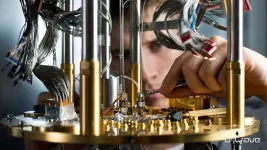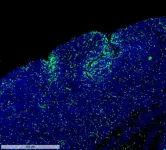(Press-News.org) Physicists have performed a groundbreaking simulation they say sheds new light on an elusive phenomenon that could determine the ultimate fate of the Universe.
Pioneering research in quantum field theory around 50 years ago proposed that the universe may be trapped in a false vacuum – meaning it appears stable but in fact could be on the verge of transitioning to an even more stable, true vacuum state. While this process could trigger a catastrophic change in the Universe's structure, experts agree that predicting the timeline is challenging, but it is likely to occur over an astronomically long period, potentially spanning millions of years.
In an international collaboration between three research institutions, the team report gaining valuable insights into false vacuum decay – a process linked to the origins of the cosmos and the behaviour of particles at the smallest scales. The collaboration was led by Professor Zlatko Papic, from the University of Leeds, and Dr Jaka Vodeb, from Forschungszentrum Jülich, Germany.
The paper’s lead author Professor Papic, Professor of Theoretical Physics in the School of Physics and Astronomy at Leeds, said: “We're talking about a process by which the universe would completely change its structure. The fundamental constants could instantaneously change and the world as we know it would collapse like a house of cards. What we really need are controlled experiments to observe this process and determine its time scales.”
The researchers say this work marks a significant step forward in understanding quantum dynamics, offering exciting possibilities for the future of quantum computing and its potential for studying some of the most challenging problems around the fundamental physics of the Universe.
Simulating a Cosmic Puzzle
The research, by the University of Leeds, Forschungszentrum Jülich, and the Institute of Science and Technology Austria (ISTA), set out to understand the key puzzle of false vacuum decay – the underlying mechanism behind it. They used a 5564-qubit quantum annealer, a type of quantum machine designed by D-Wave Quantum Inc. to solve complex optimisation problems – which involve finding the best solution from a set of possible solutions – by harnessing the unique properties of quantum-mechanical systems.
In the paper, published today (04/02/2025) in Nature Physics, the team explain how they used the machine to mimic the behaviour of bubbles in a false vacuum. These bubbles are similar to liquid bubbles forming in water vapour, cooled below its dew point. It is understood that the formation, interaction and spreading of these bubbles would be the trigger for false vacuum decay.
Co-author Dr Jean-Yves Desaules, a postdoctoral fellow at ISTA, who completed his PhD at the University of Leeds, said: “This phenomenon is comparable to a rollercoaster that has several valleys along its trajectory but only one ‘true’ lowest state, at ground level.
“If that is indeed the case, quantum mechanics would allow the Universe to eventually tunnel to the lowest energy state or the ‘true’ vacuum and that process would result in a cataclysmic global event.”
The quantum annealer enabled scientists to observe the intricate “dance” of the bubbles, which involves how they form, grow, and interact in real time. These observations revealed that the dynamics are not isolated events – they involve complex interactions, including how smaller bubbles can influence larger ones. The team say their findings provide new insights into how such transitions might have occurred shortly after the Big Bang.
The paper’s first author Dr Vodeb, postdoctoral researcher at Jülich, said: “By leveraging the capabilities of a large quantum annealer, our team has opened the door to studying non-equilibrium quantum systems and phase transitions that are otherwise difficult to explore with traditional computing methods.”
New Era of Quantum Simulation
Physicists have long questioned whether the false vacuum decay process could happen and if so, how long it would take. However, they have made little progress in finding answers due to the unwieldy mathematical nature of quantum field theory.
Instead of trying to crack these complex problems, the team set out to answer more simple ones that can be studied using newly available devices and hardware. This is thought to be one of the first times scientists have been able to directly simulate and observe the dynamics of false vacuum decay at such a large scale.
The experiment involved placing 5564 qubits — the elementary building blocks of quantum computing— into specific configurations that represent the false vacuum. By carefully controlling the system, the researchers could trigger the transition from false to true vacuum, mirroring the bubbles' formation as described by false vacuum decay theory. The study used a one-dimensional model, but it is thought 3D versions will be possible on the same annealer. The D-Wave machine is integrated into JUNIQ, the Jülich UNified Infrastructure for Quantum computing at the Jülich Supercomputing Centre. JUNIQ provides science and industry access to state-of-the-art quantum computing devices.
Professor Papic said: “We are trying to develop systems where we can carry out simple experiments to study these sorts of things. The time scales for these processes happening in the universe are huge, but using the annealer allows us to observe them in real time, so we can actually see what's happening.
“This exciting work, which merges cutting-edge quantum simulation with deep theoretical physics, shows how close we are to solving some of the universe’s biggest mysteries.”
The research was funded by the UKRI Engineering and Physical Sciences Research Council (EPSRC) and the Leverhulme Trust. The findings show that insights into the origin and the fate of the Universe need not always require multi-million-pound experiments in dedicated high-energy facilities, such as the Large Hadron Collider at CERN.
Professor Papic added: “It’s exciting to have these new tools that could effectively serve as a table-top ‘laboratory’ to understand the fundamental dynamical processes in the Universe.”
Real-World Impact
Researchers say their findings highlight the quantum annealers’ potential in solving practical problems far beyond theoretical physics.
Beyond its importance for cosmology, the study has practical implications for advancing quantum computing, according to the researchers. They believe that understanding bubble interactions in the false vacuum could lead to improvements in how quantum systems manage errors and perform complex calculations, helping to make quantum computing more efficient.
Dr Vodeb concluded: “These breakthroughs not only push the boundaries of scientific knowledge but also pave the way for future technologies that could revolutionise fields such as cryptography, materials science, and energy-efficient computing.”
Dr Kedar Pandya, EPSRC Executive Director for Strategy said: “Curiosity-driven research is a critical part of the work EPSRC supports. This project is a great demonstration of that work, with ideas from fundamental quantum physics coming together with technological advances in quantum computing to help answer deep questions about the nature of the Universe.”
University of Leeds
The University of Leeds is one of the largest higher education institutions in the UK, with more than 40,000 students from about 140 different countries. We are renowned globally for the quality of our teaching and research.
We are a values-driven university, and we harness our expertise in research and education to help shape a better future for humanity, working through collaboration to tackle inequalities, achieve societal impact and drive change.
The University is a member of the Russell Group of research-intensive universities, and is a major partner in the Alan Turing, Rosalind Franklin and Royce Institutes www.leeds.ac.uk
Follow University of Leeds or tag us into coverage: Bluesky | Facebook | LinkedIn | Instagram
Institute of Science and Technology Austria (ISTA)
The Institute of Science and Technology Austria (ISTA) is a PhD-granting research institution located in Klosterneuburg, 18 km from the center of Vienna, Austria. ISTA employs professors on a tenure-track model, post-doctoral researchers, and PhD students. The Graduate School of ISTA offers fully funded PhD positions to highly qualified candidates with a Bachelor’s or Master’s degree in biology, mathematics, computer science, physics, chemistry, and related areas. While dedicated to the principle of curiosity-driven research, ISTA aims to deliver scientific findings to society through technological transfer and science education. The President of the Institute is Martin Hetzer, a renowned molecular biologist, and former Senior Vice President at The Salk Institute for Biological Studies in California, USA. www.ista.ac.at
Jülich Supercomputing Centre / Forschungszentrum Jülich
Shaping change: This is what drives us at Forschungszentrum Jülich. As a member of the Helmholtz Association with more than 7,400 employees, we conduct interdisciplinary research into a digitized society, a climate-friendly energy system, and a sustainable economy. We focus on natural, life, and engineering sciences in the fields of information, energy, and bioeconomy.
The Jülich Supercomputing Centre (JSC) at Forschungszentrum Jülich provides researchers in Germany and Europe with computing time on supercomputers and operates JUNIQ, a European quantum computing infrastructure. JSC scientists combine expertise in supercomputing and AI, develop reliable AI tools and models, and are highly sought-after experts in science and industry.
EPSRC
The UKRI Engineering and Physical Sciences Research Council (EPSRC) is the main funding body for engineering and physical sciences research in the UK. Our portfolio covers a vast range of fields from digital technologies to clean energy, manufacturing to mathematics, advanced materials to chemistry.
EPSRC invests in world-leading research and skills, advancing knowledge and delivering a sustainable, resilient and prosperous UK. We support new ideas and transformative technologies which are the foundations of innovation, improving our economy, environment and society. Working in partnership and co-investing with industry, we deliver against national and global priorities.
The Leverhulme Trust
Since its foundation in 1925, the Leverhulme Trust has provided grants and scholarships for research and education, funding research projects, fellowships, studentships, bursaries and prizes; it operates across all academic disciplines, the intention being to support talented individuals as they realise their personal vision in research and professional training. Today, it is one of the largest all-subject providers of research funding in the UK, distributing approximately £120 million a year. www.leverhulme.ac.uk
END
Quantum machine offers peek into “dance” of cosmic bubbles
2025-02-04
ELSE PRESS RELEASES FROM THIS DATE:
How hungry fat cells could someday starve cancer to death
2025-02-04
How Hungry Fat Cells Could Someday Starve Cancer to Death
Scientists transformed energy-storing white fat cells into calorie-burning ‘beige’ fat. Once implanted, they outcompeted tumors for resources, beating back five different types of cancer in lab experiments.
Liposuction and plastic surgery aren’t often mentioned in the same breath as cancer.
But they are the inspiration for a new approach to treating cancer that uses engineered fat cells to deprive tumors of nutrition.
Researchers at UC San Francisco used the gene editing technology CRISPR to turn ordinary white fat cells into “beige” fat cells, which voraciously consume calories to make ...
Breakthrough in childhood brain cancer research could heal treatment-resistant tumors, keep them in remission
2025-02-04
Brain cancer is the second-leading cause of death in children in the developed world. For the children who survive, standard treatments have long-term impacts on their development and quality of life, particularly in small children and infants.
Research out of Emory University and QIMR Berghofer Medical Research Institute in Queensland, Australia, has shown that a potential new targeted therapy for childhood brain cancer is effective in infiltrating and killing tumor cells in preclinical models tested in mice.
In ...
Research discovery halts childhood brain tumor before it forms
2025-02-04
Scientists at The Hospital for Sick Children (SickKids) have discovered a way to stop tumour growth before it starts for a subtype of medulloblastoma, the most common childhood malignant brain cancer.
Brain cancer presents a unique set of challenges for researchers – by the time a person experiences symptoms, the tumours are often so complex that the fundamental mechanisms driving the tumour growth are no longer easy to identify. A research team led by Dr. Peter Dirks is working to combat ...
Scientists want to throw a wrench in the gears of cancer’s growth
2025-02-04
Preventing the cell’s protein factories from making the notorious cancer-causing protein MYC could stop out-of-control tumors.
For decades, scientists have tried to stop cancer by disabling the mutated proteins that are found in tumors. But many cancers manage to overcome this and continue growing.
Now, UCSF scientists think they can throw a wrench into the fabrication of a key growth-related protein, MYC, that escalates wildly in 70% of all cancers. Unlike some other targets of cancer therapies, MYC can be dangerous simply due to its abundance.
In a paper that appears Feb. 4 in Nature Cell Biology, researchers at UC San Francisco ...
WSU researcher pioneers new study model with clues to anti-aging
2025-02-04
SPOKANE, Wash. — Washington State University scientists have created genetically-engineered mice that could help accelerate anti-aging research.
Globally, scientists are working to unlock the secrets of extending human lifespan at the cellular level, where aging occurs gradually due to the shortening of telomeres–the protective caps at the ends of chromosomes that function like shoelace tips to prevent unraveling. As telomeres shorten over time, cells lose their ability to divide for healthy ...
EU awards €5 grant to 18 international researchers in critical raw materials, the “21st century's gold”
2025-02-04
The new EU-funded consortium “ForMovFluid” will study how fluids transformed the materials inside the Earth's crust. Thanks to the Marie Skłodowska-Curie Action Doctoral Networks programme, ForMovFluid will fund the doctoral studies of 18 researchers, and train them to become elite experts in the field of geoscience.
Moreover, this project will allow us to understand the origin of the so-called critical raw materials, of vital importance for the energy transition. Over a period of four years, ForMovFluid “Marie Curie” researchers ...
FRONTIERS launches dedicated call for early-career science journalists
2025-02-04
FRONTIERS announces a new call for applications for its Science Journalism in Residency Programme, funded by the European Research Council (ERC). This
third call is exclusively aimed at early-career journalists and will remain open until May 6, 2025, at 17h00 CEST.
Science journalists with up to five years of experience are invited to apply for a residency at a research institution of their choice, in an EU Member State or a
country associated with the EU’s Horizon Europe Programme. The residencies, lasting between three to five months, should focus on frontier science topics, in
collaboration with scientists.
The ...
Why do plants transport energy so efficiently and quickly?
2025-02-04
The efficient conversion of solar energy into storable forms of chemical energy is the dream of many engineers. Nature found a perfect solution to this problem billions of years ago. The new study shows that quantum mechanics is not just for physicists but also plays a key role in biology.
Photosynthetic organisms such as green plants use quantum mechanical processes to harness the energy of the sun, as Prof. Jürgen Hauer explains: “When light is absorbed in a leaf, for example, the electronic excitation energy is distributed over several states ...
AI boosts employee work experiences
2025-02-04
A new paper in the Quarterly Journal of Economics, published by Oxford University Press, shows customer service workers using artificial intelligence assistance become more productive and work faster. The effects vary significantly, however. Less experienced and lower-skilled employees improve both the speed and quality of their work, while the most experienced and highest-skilled workers see small gains in speed and small declines in quality. The researchers also found that AI assistance can help worker learning and improve English fluency, particularly for international workers.
Computers and software have transformed the economy with their ability to perform certain tasks with far ...
Neurogenetics leader decodes trauma's imprint on the brain through groundbreaking PTSD research
2025-02-04
BELMONT, Massachusetts, USA, 4 February 2025 - In a comprehensive Genomic Press Interview, Dr. Kerry Ressler, Chief Scientific Officer at McLean Hospital and Professor of Psychiatry at Harvard Medical School, unveils groundbreaking advances in understanding the neurobiological basis of post-traumatic stress disorder (PTSD) and related anxiety conditions.
Dr. Ressler's research bridges the gap between molecular neuroscience and clinical psychiatry, focusing on how the amygdala processes fear and trauma at cellular and genomic levels. "Most proximally, I hope that our work may lead to novel approaches to fear- and trauma-related disorders, perhaps even to prevent ...





